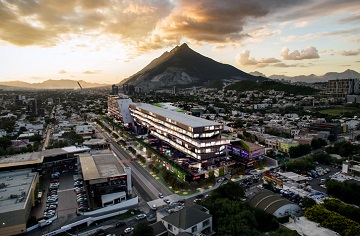
Mixed-use Projects Find Foothold in Latin America
Bryan Wroten | Hotel News Now
GLOBAL REPORT—Latin America is finding its appetite for hotels developed in combination with residential and commercial spaces.
In a webinar hosted by Jones Lang LaSalle’s Hotels & Hospitality Group titled “Latin American hotel design, technology and project trends:Mixed-use projects: Trending project model,” developers and hotel brand representatives spoke about their current and upcoming projects as well as the future of this type of project.
“We are seeing a large trend now in the region for mixed-use development,” said Patricio del Portillo, director of development and acquisitions for Mexico and Central America at Starwood Hotels & Resorts Worldwide.
Finding the right mix
Starwood’s two mixed-use projects in the works are the Westin Puebla and the Westin Monterrey, del Portillo said. The Westin Puebla is a 150-key hotel matched with 10,000 square meters (32,808.4 square feet) of office space and 100 branded residences, he said. It’s a dense property, as it’s being developed on 7,000 square meters (22,965.9 square feet) of land.
The Westin Monterrey is part of a 230,000-square-meter (754,693.2-square-foot) mixed-use project. The 180-key hotel is paired with 33,000 square meters (108,267.7 square feet) of retail, he said.
The Playa del Carmen near Cancun, Mexico, is another example of a mixed-use property in the region. When designing the project, Francisco Navarro, CFO at Thor Urbana Capital, said the company put an avenue between the hotel and the retail building that’s crowded by visitors.
“The objective was redeveloping all the assets into a lifestyle center,” he said.
The Westin Resort & Spa Los Cabos opened in 1994 with 243 hotel rooms and has 130 timeshare units on one side of the complex, said Gustavo Ripol, principal at Leisure Partners,. The property underwent an expansion with whole and fractional ownership units. The entire project proved to be “extremely successful,” he said.
“The mixed-use created incredible synergies with the hotel, timeshares and the whole and fractional ownership,” he said, adding the hotel benefits dramatically from the timeshare units adjacent to it having almost 100% occupancy year round.
At another project, the Banyan Tree Mayakoba has 60 hotel rooms and 40 whole and fractional ownership units, Ripol said. Despite opening as an ultra-luxury site in 2009 during the worst possible tourism crisis—the recession along with an outbreak of the “swine flu” in Mexico—the property stabilized and has become successful.
“All the real estate sold out,” he said. “There is an expansion planned right now.”
Seeking a profit
As an investor and developer, Ripol said Leisure Partners looks at the players in the equation, those players’ interests, how many concepts there are and how they would interact. The company also analyzes the scope of the project, since mixed-use projects tend to be large and have more moving parts and bigger challenges to overcome.
Investors and developers need to see how the synergies created by the project increase profitability and whether that outweighs the challenges brought about by the complexity, he said.
“You have to ponder not only the different components in terms of their individual benefits but also how they interact with each other, how they’re going to operate and most importantly what your exit strategy is going to be if and when and for how much,” Ripol said.
In terms of return on investment, these mixed-use projects are going to be long-term investments of more than 10 years, Navarro said, because these projects are creating products that do not exist in the landmark sites in Mexico’s main cities. With that long-term vision and the successful execution of the development and ongoing operations, the project will be profitable for investors.
“We see the returns of these assets are higher than an isolated product,” Navarro said.
The ups and downs
Webinar moderator Clay Dickinson, managing director responsible for Latin America advisory and asset management at JLL, explained mixed-use projects present some synergies and benefits for hotel owners. The synergies created when a project is developed correctly can have a halo effect, he said.
“Having a very strong hotel brand with a good strong retail component can actually increase the absorption pace of your office space, the types of leases and rates you’re able to command, etc.,” he said. “If you have a really strong retail component, you can actually command (average daily rate) premiums upwards of 20% to 25% sometimes if the hotel is part of a successful overall mixed-use project.”
Mixed-use projects can have strong financial performance, Dickinson said, because there are greater cash flows from shared operations of things like parking.
Shared facilities also allow developers to build more robust spa and workout facilities because each entity in the complex can use them, he said. While the overall design and development will be more complex than a standalone hotel, it also has decreased individual component costs because of the shared use.
The projects also create an extension of the hotel brands, Dickinson said.
“The move into lifestyle is something of a trend that’s caught on,” he said. “They’re leveraging them in to redesigning the product. That’s starting to spill over with retailers or clothing designers. They’re extending that brand into hotels as well.”
While a mixed-use project has these built-in benefits, Dickinson cautioned that there potential challenges to consider before moving forward. One example is there can be operational conflicts when hotels are paired with residential units.
“Residents feel like, ‘This is my house. I don’t want transient guests,’” he said. “The guests feel this guy is walking around like he owns the place.”
In some locations, the restaurants in the retail areas can pull away from the food-and-beverage options in the hotel, he said. In those cases, it might be better to build a focused- or select-service hotel.
Similarly, mixed-use projects can have cross-contamination problems where an ill-conceived component doesn’t perform well and pull down the entire project, Dickinson said, such as a failed retail concept that doesn’t attract people to spend at the hotel.
